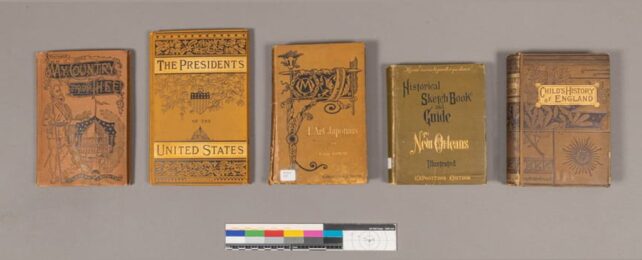Toxic dyes once used to imbue cloth-bound books with their vivid hues may still be toxic to their readers.
An analysis of Victorian-era books has revealed the presence of toxic materials such as lead and chromium. The good news is so long as you don't go around licking them, casual contact with the heavy metals isn't likely to deliver quantities high enough to do serious harm.
With that in mind, people who handle antique books a lot, like librarians and book dealers, are at a high risk.
The findings have been presented in a poster at the Fall meeting of the American Chemical Society.
"These old books with toxic dyes may be in universities, public libraries and private collections," says chemist Abigail Hoermann of Lipscomb University in the US. "So, we want to find a way to make it easy for everyone to be able to find what their exposure is to these books, and how to safely store them."
During the 19th century, a new class of dyes rose to prominence. No longer were vivid hues to be solely produced by difficult-to-find, natural ingredients. Arsenic produced spectacular, almost neon greens and magentas. Aniline was used to create deep blacks and startling purples. Other heavy metals help make dyes more stable, keeping them brighter for longer.
The result was more than a few unpleasant deaths, especially for factory workers. Victorian-era costuming is no longer common attire, and we have since learned not to dye our clothes and books with substances that will slowly poison us. Still, other vintage objects may not be quite so safe.
In 2019, art conservationists Melissa Tedone and Rosie Grayburn of the Winterthur Museum, Garden & Library in the US noticed a book whose cloth cover was dyed with a pigment known to contain arsenic. Since then, the Poison Book Project has identified many books around the world dyed with the same toxic pigment.
Piqued by this project, Lipscomb University librarians Jan Cohu and Michaela Rutledge approached chemist Joseph Weinstein-Webb of Lipscomb University to see if brightly colored books in their own library's collection also contained toxic dyes.
Weinstein-Webb and his team subjected a number of books to a battery of tests, including X-ray fluorescence to check for arsenic and other heavy metals; inductively coupled plasma optical emission spectroscopy to discern the concentration of those metals; and X-ray diffraction, to identify the pigment molecules that contain the metals, the first time this technique has been used on books.
This revealed the presence of lead and chromium in high, unsafe concentrations in some of the samples. In some cases, this was in the form of lead(II) chromate, a yellow pigment most famous for the brilliant coloring of Vincent van Gogh's Sunflowers.
But lead(II) chromate contains equal amounts of lead and chromium, and the books were found to contain much higher concentrations of lead than chromium. This likely means that there are other dyes used that contain different concentrations of the metals. The researchers are working to find out what they are.
Meanwhile, the books have been sealed in plastic and removed from circulation: some samples were found to contain twice the lead, and six times the chromium concentrations than the limits for acceptable exposure as set by the CDC, the researchers say.
"I find it fascinating to know what previous generations thought was safe, and then we learn, oh, actually, that might not have been a great idea to use these brilliant dyes," Weinstein-Webb says.
The team presented its findings so far at the 2024 Fall meeting of the American Chemical Society.
